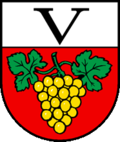Vallamand
| Vallamand | ||
|---|---|---|
| State : |
|
|
| Canton : |
|
|
| District : | Broye-Vully | |
| Municipality : | Vully-les-Lacs | |
| Postal code : | 1586 | |
| former BFS no. : | 5462 | |
| Coordinates : | 569 558 / 197919 | |
| Height : | 516 m above sea level M. | |
| Area : | 2.36 km² | |
| Residents: | 389 (December 31, 2010) | |
| Population density : | 165 inhabitants per km² | |
| Website: | www.vully-les-lacs.ch | |
| map | ||
|
|
||
Vallamand was a municipality in the Broye-Vully district in the canton of Vaud in Switzerland . On July 1, 2011, Vallamand went up in the new municipality of Vully-les-Lacs . The place Vallamand consists of the two parts Vallamand-Dessus , which formed the actual political municipality Vallamand, and Vallamand-Dessous , which belongs politically to the municipality Bellerive . Both districts are thus united in the new municipality of Vully-les-Lacs.
geography
Vallamand lies at 516 m above sea level. M. , 14.5 kilometers northeast of the district capital Payerne ( linear distance ). The farming village extends on a promontory on the southern slope of the ridge between Lake Neuchâtel and Lake Murten , in a panoramic position around 80 m above the lake level of Lake Murten, in the Swiss plateau .
The area of the 2.4 km² municipal area includes a section on the northwestern shore of Lake Murten. The municipal soil extends from the lake shore northwards over the flat edge of the bank ( Pré des Peupliers ) to the broad Molasse ridge, which forms the southwestern continuation of Mont Vully . In the forest area Bois de l'Allou is 588 m above sea level. M. reached the highest point of Vallamand. East of the village, the Ruisseau de Ferrages brook has carved a deep erosion valley into the molasse layers over the course of millions of years. In 1997, 14% of the municipal area was in settlements, 23% in forests and woodlands, 62% in agriculture and a little less than 1% was unproductive land.
Vallamand has a number of individual farms and holiday homes near the shore of Lake Murten. Vallamand's neighboring communities were Bellerive , Cudrefin and Mur .
population
With 389 inhabitants (as of December 31, 2010) Vallamand was one of the small communities in the canton of Vaud. 57.8% of the residents are French-speaking, 38.4% German-speaking and 2.1% English-speaking (as of 2000). The official language is French. The population of Vallamand was 282 in 1860, compared to 340 in 1900. After the population had decreased to 211 by 1980, a significant increase in population has been registered since then. The proportion of the German-speaking population is growing rapidly. In 1990 the proportion was still 25%.
economy
Vallamand was a predominantly agricultural village until the second half of the 20th century . Even today, the have farming and fruit growing an important role in the employment structure of the population. Wine is grown on the southern slopes above Lake Murten, which are optimally exposed to the sun . Further jobs are available in local small businesses and in the service sector. In the last few decades the village has also developed into a residential community. Some workers are commuters who work in the surrounding larger towns. Vallamand has had a sport boat harbor on Lake Murten since 1998 with around 200 berths.
traffic
The community is located off the main thoroughfares on a connecting road from Salavaux to Cudrefin . Vallamand is connected to the public transport network through the Postbus course, which runs from Avenches to Cudrefin.
history
Finds from the Hallstatt period prove a very early settlement in the municipality of Vallamand. The first written mention of the place took place in 1246 under the name Ualamant ; In 1668 the name Valaman appeared . The place name is made up of the word Val (valley) and the personal name Amandus or Amantius .
Vallamand was part of the Kastlanei Cudrefin since the Middle Ages , which was under the lords of Grandson until 1397, then under the influence of Savoy. With the conquest of Vaud by Bern in 1536, the village came under the administration of the Bailiwick of Avenches . After the collapse of the Ancien Régime , Vallamand was annexed to the canton of Friborg during the Helvetic period in 1798 . When the Mediation Constitution came into force in 1803, the village, together with what is now the Avenches district, was reassigned to the Canton of Vaud as an exclave. A preliminary study for the merger of Vallamand with the municipalities of Constantine , Bellerive and Montmagny is currently in progress (2005) .
Attractions
The Vallamand Chapel was built in 1899. The parish belongs to the parish of Montet-Cudrefin. In the center of the village there are some typical farm and wine-growing houses from the 17th to 19th centuries.


